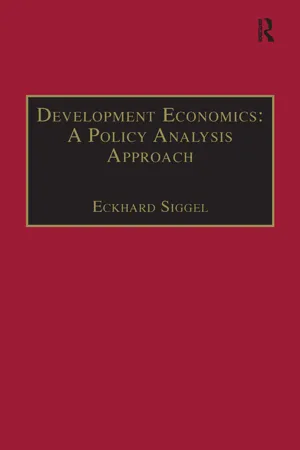Growth Rate of Functions
The growth rate of functions refers to how quickly a function's output value increases as its input value grows. It is often used to compare the efficiency of algorithms and the performance of computer programs. Common growth rates include constant, logarithmic, linear, polynomial, exponential, and factorial, with each representing a different rate of growth.
3 Key excerpts on "Growth Rate of Functions"
- eBook - ePub
- Gregory Hill, Mel Friedman(Authors)
- 2013(Publication Date)
- Research & Education Association(Publisher)
...The negative just indicates downward direction. The object strikes the ground with a speed of 96 feet per second, which is more than 60 miles per hour! EXPONENTIAL GROWTH AND DECAY A vast number of functions in science and economics behave exponentially and have a unique phenomenon regarding their rates of change. For an exponential function of the form, y = a · e kx, where a and k are constants, the ratio of the slope at any point of the function to the function value at that point is constant. A common way to state this is: “The rate of change of a function is proportional to the function.” In symbols, it is written, where y is a function of t and k is a constant sometimes called the relative growth rate. This holds true for unchecked growth of a population, radioactive decay of isotopes, velocity of an object coasting to a stop, capacitor discharge, and growth of investments under continuously compounded interest, to name a few. Solving the differential equation will show how an exponential function results. So y = Ae kt where A = ± e c. The sign and value of A is determined by the initial condition. EXAMPLE 7.8 The instantaneous rate of growth of the population of a booming suburban town is 4% of the population at any given time. If the population this year is 130,000 people, find a model for the population as a function of years beyond this current year. SOLUTION Currently, t = 0, and P (0) = 130,000. So 130,000 = Ae 0.04(0) ⇒ 130,000 = A and P = 130,000 e 0.04 t Of course, once the conditions that give rise to an exponential function are recognized, all the solution steps can be bypassed, and one can jump directly to the solution. EXAMPLE 7.9 A capacitor is losing voltage at a rate proportional to the voltage passing over its terminals. Let where t is time in seconds...
- eBook - ePub
- Arsen Melkumian(Author)
- 2012(Publication Date)
- Routledge(Publisher)
...4 Limits and derivatives In mathematics, differential calculus is a subfield of calculus that is concerned with the study of how quickly functions change over time. The primary concept in differential calculus is the derivative function. The derivative allows us to find the rate of change of economic variables over time. This chapter introduces the concept of a derivative and lays out the most important rules of differentiation. To properly introduce derivatives, one needs to consider the idea of a limit. We cover the concept of a limit in the first section. The chapter closes with growth rates of discrete and continuous variables. 4.1 Limits Consider a function g given by and shown in Figure 4.1. Clearly, the function is undefined for x = 0, since anything divided by zero is undefined. However, we can still ask what happens to g (x) when x is slightly above or below zero. Using a calculator we can find the values of g (x) in the neighborhood of x = 0, as shown in Table 4.1. As x approaches zero, g (x) takes values closer and closer to 2. So we can say that g(x) tends to 2 as x tends to zero. We write and say that the limit of g (x) as x approaches zero is equal to 2. Now that the idea of a limit is clear on an intuitive level, let us consider a formal definition of the right- and left-hand side limits. Let f be a function defined on some open interval (a, b). We say that L is the right-hand side limit of f (x) as x approaches a from the right and write if for every ε > 0 there is a δ > 0 such that Figure 4.1 Table 4.1 whenever As an example, let us consider the following function We want to show that Let us choose ε > 0. We need to show that there is a δ > 0 such that whenever Let us choose δ = (ε/ 2). Then, and therefore It follows immediately that whenever Now we have proved that the limit of as x approaches zero from the right is equal to 1. Now let us define a left-hand side limit. Let f be a function defined on some open interval (a, b)...
- Eckhard Siggel(Author)
- 2016(Publication Date)
- Routledge(Publisher)
...Taking the letter Y for either of these income concepts, N for the size of population, and y = Y/N for per capita income, g y = Δ(Y/N)/(Y/N) is the proportional growth rate of per capita income. Whenever we observe growth over a period of several years, we can express the average annual growth rate in two different ways, the continuous and the discrete growth rate. The continuous growth rate describes a process in which the increment is added continuously to the base value, so that a constant growth rate results in a continuously growing increment. This type of growth is known as continuous exponential growth and is described by the function: (1.1) Y t = Y 0 e gt where Y 0 and Y t, are income levels in the base year and in year t respectively, and g is the continuous annual growth rate. Its geometric representation is a continuously and exponentially rising curve. Alternatively, we can view growth as a process in which the yearly increment is added to the previous-year value only once a year, so that we obtain a growth function that rises linearly during the year, but the yearly increment becomes larger every year. It obeys the function: (1.2) Y t = Y 0 (1+g) t where g is the discrete annual growth rate. This process is described by a sequence of straight-line segments with an increasing slope. In practical growth analysis the analyst faces a series of observations on Y or any other aggregate over a period of time. The first objective is then to express the growth process by a single number, such as the annual average growth rate over the whole period. It is computed by solving either of the expressions 1.1 or 1.2 for g, obtaining the continuous (g c) or the discrete annual growth rate (g d). This procedure amounts to connecting the first-year point with the end-year point by lines that behave differently in the continuous and discrete cases, as described above...


